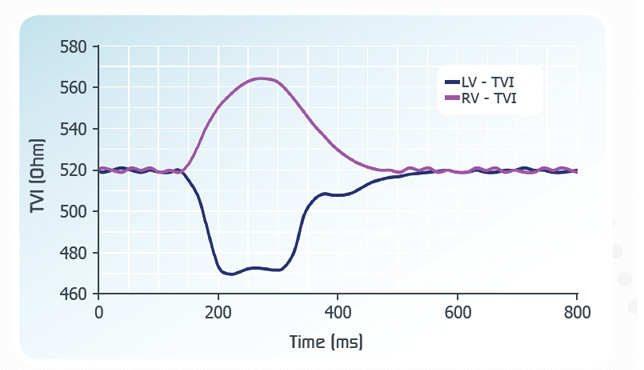
Hera (DDD-Biventricular)





Hemodynamic optimization of cardiac resynchronization therapy
TVI signal display by real-time telemetry, in RV or LV configuration.
TVI signal processing, with waveform averaging, analysis and on-screen display
TVI in RV configuration is the trans-valvular impedance derived between endocardial electrodes positioned in right atrium and ventricle. The RV-TVI increases in systole and decreases in diastole, following the time-course of RV contraction and relaxation.

TVI signal amplitude and morphology reflect the mechanical performance of the heart.
The comparison of averaged TVI waveforms recorded as a function of the VV delay indicates the best stimulation timing.
The LV-TVI is the impedance derived between right atrium and the cardiac vein containing the LV pacing lead. The LV-TVI decreases in systole and increases in diastole. The diastolic rise back to baseline outlines the progress of LV relaxation.

The lag between RV- and LV-TVI waveforms reflects the interventricular desynchronization. The stimulation timing should be aimed at the best synchronization of RV- and LV-TVI signals.
High flexibility in biventricular pacing with device autoregulation
Sensing and pacing parameters setting in 3 independent chambers, with the optional application of an interventricular delay and selection of the ventricle to be stimulated first. If required, pacing in the 2nd ventricle can be inhibited by electrical sensing on the corresponding channel. This allows a safety Hisian stimulation. The pacemaker is able, in fact, to provide a back-up stimulus in the right ventricle apex, in case of Hisian ineffective stimulation.
Ejection check after ventricular pacing function with automatic adjustment of pacing energy in case of capture loss
Ejection check after ventricular sensing algorithm with an automatic safety pacing in case of external interferences
Long-term comparison of ventricular mechanics to monitor the CRT effects on the pump function
In patients with heart failure is essential to monitor the resynchronization therapy effects . To this end, in case of significant decay of hemodynamic performance an appropriate warning will be visible to the user on the programmer’s screen.
Tachyarrhythmic episodes can be correctly and exhaustively assessed thanks to the synergy between iECG (electrical information) and TVI (hemodynamic information)
Supraventricular and ventricular tachycardias can be easily distinguished based on the different iECG pattern.
TVI provides information on the presence of hemodynamic activity and the reliability of ventricular mechanic performance.

In case of SVT, the ventricular component of the iECG is a fast waveform showing the same essential features as the signal recorded in sinus rhythm. Regular TVI fluctuation indicates that the pump function is preserved.

In case of VT, the iECG shows a wide ventricular complex, clearly different from the signal associated with the conduction on the His-Purkinje system. Hemodynamically tolerated VTs feature a reduced, but stable, TVI fluctuation; in contrast, the TVI signal is markedly depressed or totally absent if the pump function is not reliable.
![]() For more information or to get technical support on our products please CONTACT US >>
For more information or to get technical support on our products please CONTACT US >>
Products | Technology | Support | Contacts
